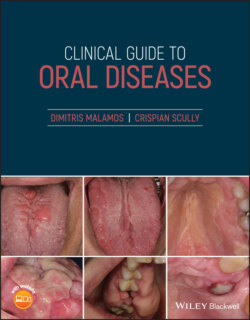Читать книгу Clinical Guide to Oral Diseases - Crispian Scully - Страница 34
Case 2.9
ОглавлениеFigure 2.9
CO: A 67‐year‐old woman presented with bluish swellings on the ventral surface of her tongue.
HPC: The lesions were discovered accidentally by the patient a few years ago and have remained the same since then.
PMH: Hypertension was treated with captopril (angiotensin converting enzyme [ACE]‐analog) drugs, hyperlipidemia (mild) controlled with atorvastatin and sleeping apnea which responded well to the use of a continuous positive pressure airway ventilator during sleeping. No local trauma was reported and only vascular surgery for enlarged veins of both her legs three years ago was reported.
OE: Two large corrugated blue lesions on the ventral surface of the tongue extending from the floor of the mouth to the tip of tongue. The lesions are located symmetrically to the lingual frenum, but the right lesion showed an enlargement close to the floor of the mouth (Figure 2.9). By applying a mild pressure, their color and width was reduced, but returned when the pressure was released. These lesions are asymptomatic, but cause mild discomfort with eating or speaking. No other similar lesions were found within the mouth or other mucosae in this patient or among her close relatives.
Q1 What is the diagnosis?
1 Hemangioma
2 Eruption cysts
3 Kaposi sarcoma
4 Hemorrhagic ranula
5 Lingual varicosities
Answers:
1 No
2 No
3 No
4 No
5 Enlarged lingual varicosities are abnormal, dilated lingual veins, highly visible in older patients (> 60 years old) and are sometimes associated with thrombophlebitis of the legs as seen in this lady.
Comments: The lack of trauma at the ventral surface of the tongue excludes hemorrhagic ranula from diagnosis. Hemangiomas can bleach or reduce their size with pressure, but in contrast to the lady's lesion, they have a tendency to shrink over time. Sarcoma Kaposi is a vascular neoplasia that is mainly seen in patients with immunodeficiencies, while eruption cysts are bluish lesions which are found in the alveolar mucosa and associated with the crowns of unerupted teeth.
Q2 What is/are the difference(s) between varicoses and spider veins?
1 Location
2 Color
3 Size
4 Symptomatology
5 Predilection (age or sex)
Answers:
1 Spider veins are seen only on the skin of the face or associated with varicose veins on the legs, while varicoses are seen on the skin of the legs, but also on other parts of body.
2 No
3 Spider veins are smaller in size than varicose veins
4 No
5 No
Comments: Both veins have a tendency to appear in middle‐aged women and cause patients cosmetic concern due to their skin distribution and/or dark red or bluish discoloration, as well as their symptomatology of burning sensation, pain, or even ulcer formation.
Q3 Which is the treatment for asymptomatic lingual varicosities?
1 Use beta blockers
2 Laser application
3 Band ligation
4 Embolization
5 None required
Answers:
1 No
2 No
3 No
4 No
5 Asymptomatic lingual varicoses do not require any treatment apart from reassurance for patients with a fear of cancer.
Comments: Laser application is useful for the elimination of facial spider veins and not of tongue varicoses. The systematic use of beta blockers reduces the risk of venous hemorrhage in patients with portal hypertension due to cirrhosis, while embolization and band ligation are widely used to cope with an acute hemorrhage that arises from large esopharyngeal and gastric rather than lingual veins.
